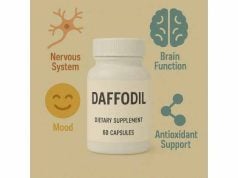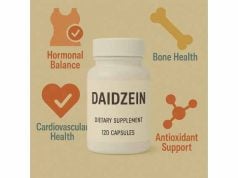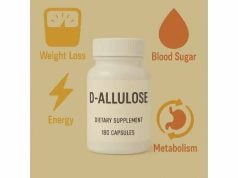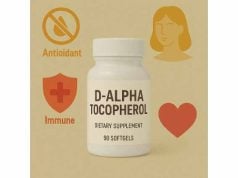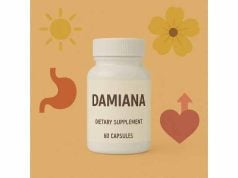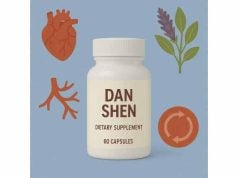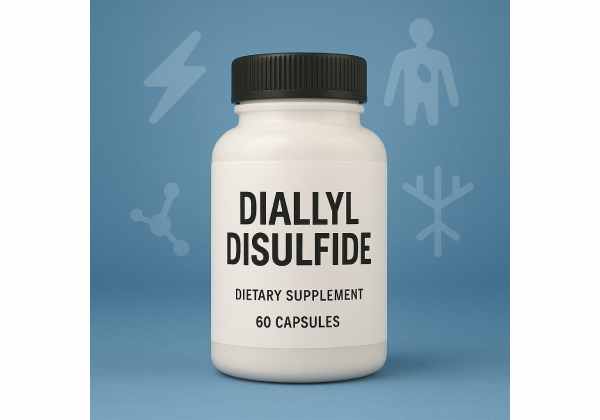
Diallyl disulfide (DADS) is a sulfur-rich molecule that gives garlic much of its punch—in scent and in biology. It forms when fresh garlic is crushed and allicin breaks down, and it concentrates in steam-distilled garlic oils. In the lab, DADS influences pathways linked to oxidative stress, inflammation, and cell signaling, which helps explain why garlic has long been studied for immune, metabolic, and cardiovascular health. Still, most evidence comes from mechanistic and animal research; human data typically evaluate whole garlic or garlic oils that contain a mixture of allyl sulfides (not DADS alone). This guide translates the science into practical takeaways—how DADS works, what benefits are realistic now, how to use garlic-oil products that provide DADS, sensible dose ranges based on composition data, and where safety lines sit.
Quick Diallyl Disulfide Highlights
- Lab and animal data suggest anti-inflammatory and antioxidant effects; human outcomes come mainly from garlic or garlic-oil trials.
- Acts on redox and inflammatory pathways (for example, Nrf2 and NF-κB) and may affect epigenetic enzymes; evidence in people is limited.
- No established DADS-only dose; garlic-oil studies used 1–2 mg oil twice daily; typical oils contain ~20–30% DADS.
- Safety caveat: allyl sulfides can irritate skin, eyes, and airways; rare allergies occur, and reflux or GI upset is possible.
- Avoid or get medical guidance if pregnant, breastfeeding, on anticoagulants or antiplatelets, or if you have enzyme/sulfur allergies.
Table of Contents
- What is diallyl disulfide and how it works
- What benefits are realistic today
- How to use diallyl disulfide or garlic oil
- How much diallyl disulfide per day
- Side effects, safety, and who should avoid
- Research snapshot and open questions
What is diallyl disulfide and how it works
Diallyl disulfide (DADS) is one of several “allyl sulfides” that arise when you crush, chop, or distill garlic. Allicin—the unstable compound responsible for garlic’s immediate aroma—quickly rearranges into more stable molecules, including DADS and its siblings diallyl sulfide (DAS) and diallyl trisulfide (DATS). In steam-distilled garlic oil, these allyl sulfides dominate the chemical profile; across analyses, DADS often accounts for roughly one-fifth to one-third of the oil, with DATS typically similar or higher. Those proportions matter later when you read labels or estimate an intake from garlic-oil softgels.
At a biochemical level, DADS is lipophilic and reactive at sulfur atoms. Those sulfur–sulfur bonds can interact with cysteine residues on proteins or contribute to changes in cellular redox status. Several mechanisms emerge repeatedly in the literature:
- Antioxidant defense signaling. DADS can upregulate endogenous defense systems—including glutathione-related enzymes—by promoting Nrf2 (nuclear factor erythroid 2–related factor 2) activity. Nrf2 drives transcription of detoxification and antioxidant genes, a plausible route to improved redox resilience.
- Inflammation modulation. DADS has been shown to down-shift pro-inflammatory signaling (for example, NF-κB nuclear translocation), with downstream effects on cytokines and enzymes that generate inflammatory mediators.
- Epigenetic enzyme effects. DADS and its metabolite allyl mercaptan have demonstrated histone deacetylase (HDAC) inhibition in cell models, which can alter gene expression programs involved in cell cycle control and stress responses.
- Mitochondrial and apoptosis pathways. In tumor cell lines and in animal models, DADS influences mitochondrial permeability, reactive oxygen species dynamics, and pro-apoptotic signaling. These findings explain why much of the DADS literature sits in oncology journals.
Because DADS is oil-soluble, you’ll mostly encounter it in steam-distilled garlic oil or essential-oil–type extracts, not in aged garlic extracts (AGE) that concentrate water-soluble compounds such as S-allyl-L-cysteine (SAC). That distinction is more than academic: AGE and garlic oils do different things in the body because they deliver different molecules at different ratios.
What DADS does not do: it is not a stimulant; it is not an antibiotic replacement; and it is not a stand-alone therapy for chronic diseases. It’s best viewed as one member of a family of garlic-derived compounds that may complement diet and lifestyle foundations. If you prefer food-first strategies, culinary garlic provides a spectrum of organosulfur molecules; heating shifts the profile (reducing allicin) but still leaves meaningful amounts of allyl sulfides in oils and cooked dishes.
What benefits are realistic today
For readers seeking clear, practical answers: evidence directly linking DADS-only supplementation to clinical outcomes in humans is limited. Most human trials use intact garlic (powders, aged extracts) or steam-distilled garlic oil that contains mixtures of allyl sulfides—DADS included. That means benefit claims for DADS per se rest mainly on mechanistic and animal data, plus composition-based inference from garlic-oil trials.
Here’s what the current evidence supports—and what it doesn’t:
Where the signal is strongest (preclinical, supportive for hypothesis-building).
In cell and animal models, DADS repeatedly:
- Activates antioxidant defenses through Nrf2-linked pathways, increasing enzymes that recycle cellular antioxidants.
- Down-modulates inflammatory signaling (e.g., NF-κB pathways), with corresponding drops in pro-inflammatory cytokines and mediators.
- Influences epigenetic regulation via HDAC inhibition (especially through allyl mercaptan), which can slow cell proliferation and promote cell-cycle checkpoints in cancer models.
- Affects mitochondrial function and apoptosis in tumor cells, with reductions in tumor growth in xenograft models and suppression of invasion/migration markers in cultured human cancer cells.
Where human data exist (but are not DADS-specific).
- Garlic-oil interventions have tested 1–2 mg oil twice daily over months to years in populations at risk for gastric lesions or in cardiometabolic contexts. Outcomes vary by formulation and study design: some trials suggest improvements in biochemical markers or reduced burden of gastric lesions; others show null effects on hard endpoints. Because the oils contain DADS alongside DATS and other sulfides, results cannot be attributed to DADS alone.
- Trials with other garlic forms (e.g., aged garlic extract) show changes in oxidative stress markers and some cardiometabolic risk factors, but those preparations lack high DADS content and emphasize different compounds (e.g., SAC). Translating AGE outcomes to DADS would be inappropriate.
What to expect in practice.
If you use a steam-distilled garlic-oil product standardized to allyl sulfides, reasonable expectations are modest and slow-build: potential support for antioxidant capacity and inflammatory tone over weeks to months, not an immediate “felt” effect. Individuals with reflux sensitivity may notice garlic-oil–related heartburn; others experience only garlic breath. For immune support during seasonal challenges, evidence remains preliminary; food-first garlic intake plus overall diet quality likely matter as much as any capsule.
What not to expect.
- DADS is not a replacement for standard therapy for infections, autoimmune disease, cancer, diabetes, or cardiovascular conditions.
- It is not a blood thinner in the medical sense, despite historical references to garlic’s antiplatelet properties; if you take anticoagulants or antiplatelets, you need medical guidance for any garlic-oil product.
Bottom line: consider DADS-containing garlic oil as a supportive nutrition component with promising mechanisms and limited human-level specificity. Choose it (if at all) to complement—not substitute—clinically proven strategies: balanced diet, exercise, sleep, and guideline-directed care.
How to use diallyl disulfide or garlic oil
Because pure DADS capsules are rare, most consumers encounter DADS via steam-distilled garlic-oil softgels (sometimes simply labeled “garlic oil”). Use and expectations hinge on three ideas: formulation, standardization, and timing.
1) Formulation: oil vs. aged extract vs. powder.
- Steam-distilled garlic oil concentrates allyl sulfides (DAS, DADS, DATS). These are lipophilic and deliver the characteristic garlic odor (and “garlic breath”) because metabolites like allyl methyl sulfide are exhaled. If your goal is to ingest DADS, garlic oil is the relevant format.
- Aged garlic extract (AGE) emphasizes water-soluble compounds (e.g., S-allyl-L-cysteine). AGE has a different evidence base and low DADS content.
- Garlic powders vary widely, depending on processing and stabilization of alliinase; many do not deliver meaningful allyl sulfide amounts comparable to garlic oil.
2) Standardization: read the numbers, not just the front label.
Look for a supplement facts panel that lists:
- Total garlic oil per softgel (often 1–2 mg).
- Optionally, the allyl sulfide profile or percent ranges (some brands disclose; many don’t). If the label does not specify, consult the brand’s technical sheet or choose a product that does. Published compositional surveys report DADS commonly in the ~20–30% range of steam-distilled oil, with DATS often ~17–33% and DAS ~2–10%. That means a 2 mg softgel may deliver roughly 0.4–0.6 mg DADS if the oil mirrors typical profiles.
3) Timing: with meals or split dosing.
Allyl sulfides are absorbed over hours. Taking garlic oil with food can reduce potential GI upset. If your daily plan includes 2 softgels, many people do well with breakfast and dinner to spread exposure.
Practical setup for first-time users.
- Pick a single variable: change only one thing—e.g., add one softgel with your largest meal—for 2–3 weeks, then reassess.
- Track signals: if your interest is cardiometabolic, track lifestyle metrics you already monitor (steps, blood pressure, diet pattern) rather than expecting an immediate sensation.
- Mind odor: if breath odor is a concern, take the softgel earlier in the day, hydrate, and include parsley or apple with meals (culinary hacks can help, though they do not eliminate exhaled allyl metabolites).
What if you prefer food-only?
Culinary garlic remains valuable. Chopping/crushing, then letting it rest 10–15 minutes before cooking preserves more allicin formation; some of that will convert to allyl sulfides with heating. Low-temperature sautés and oil infusions (food-safe methods) yield more oil-soluble sulfides relative to raw uses, although precise at-home DADS yields are unpredictable.
When not to use garlic oil for DADS.
Skip it (or get medical clearance) if you have active reflux that worsens with greasy/spicy foods, known garlic or sulfur allergy, or if you’re preparing for surgery (see safety section for medication considerations).
How much diallyl disulfide per day
There is no established, evidence-based DADS-only dosage for humans. Sensible use comes from two sources: (1) human trials that used steam-distilled garlic oil (which contains DADS), and (2) composition studies that quantify how much DADS typically appears in such oils.
What human studies actually used (garlic oil, not isolated DADS).
- Several randomized or controlled trials have used 1–2 mg garlic oil twice daily, usually for months to years, often alongside dietary counseling or other supplements. Outcomes include various biomarker shifts and, in some long-term studies, mixed effects on precancerous gastric lesions. Importantly, these trials do not isolate DADS.
How to convert oil to approximate DADS intake.
- Typical steam-distilled garlic oils contain ~20–30% DADS (with DATS often nearby or higher).
- Therefore, 1 mg of such oil provides roughly 0.2–0.3 mg DADS; 2 mg provides ~0.4–0.6 mg DADS.
- A common plan—1–2 mg twice daily—would equate to ~0.4–1.2 mg DADS per day, assuming the oil matches published averages. Individual products vary.
A stepwise, conservative approach.
- Start low: If your product contains 1 mg oil per softgel, begin with one softgel daily with food for 1–2 weeks.
- Titrate: If well tolerated and you want to mirror higher ends of studied intakes, increase to two softgels daily (split dosing).
- Evaluate: Reassess after 8–12 weeks. If you notice no benefit relevant to your goals—and you’ve optimized diet, activity, and sleep—consider discontinuing.
Special situations.
- No pediatric dosing is established.
- Pregnancy or breastfeeding: lack of targeted safety data for concentrated garlic oil; avoid unless your clinician agrees.
- Medication use: if you take antiplatelets, anticoagulants, or perioperative medications, discuss any garlic-oil plan with your care team.
- Sensitivity: if you’re prone to reflux, try with meals, not on an empty stomach, or consider a food-only garlic approach.
Do not “megadose.” More is not better with odoriferous, reactive sulfur compounds. Stay within label directions from reputable brands; choose products that disclose oil amount per softgel and—ideally—provide a certificate of analysis.
Side effects, safety, and who should avoid
Overall profile. Garlic and its allyl sulfides have a long culinary history, and safety assessments of related sulfides as flavoring substances support low risk at typical intakes. That said, concentrated garlic oils can cause irritation and GI discomfort in some users, and allergy—though uncommon—does occur.
Common, usually mild effects.
- Reflux or upper-GI discomfort, especially if taken without food.
- Garlic breath and body odor due to volatile allyl metabolites (e.g., allyl methyl sulfide) exhaled via lungs and skin; this can persist for hours.
- Occasionally loose stools or nausea at higher intakes.
Irritation and sensitization.
- Aliphatic sulfides (the family that includes DADS) are classified as irritants to skin, eyes, and airways and as potential skin sensitizers in occupational and regulatory documents. Avoid opening softgels, rupturing them on skin, or handling oils near the eyes.
- Allergic reactions—rash, wheeze, swelling—are rare but reported. Stop use and seek care if they occur.
Interactions and cautions.
- Antiplatelets/anticoagulants: Garlic products are historically associated with antiplatelet effects; interaction magnitude likely depends on the preparation. If you use aspirin, clopidogrel, warfarin, DOACs, or have a surgery scheduled, discuss garlic oil with your clinician and consider pausing 7–10 days pre-op per medical advice.
- Hypotension or antihypertensives: modest blood-pressure effects have been reported with some garlic preparations; monitor if you are on therapy.
- Pregnancy and breastfeeding: concentrated oils lack high-quality safety data; defer use unless recommended by a clinician.
- Gastroesophageal reflux disease (GERD): garlic oil can aggravate symptoms; food-only garlic or non-oil preparations may be better tolerated.
- Children: no established dosing or safety data for garlic oil; avoid without pediatric guidance.
Quality matters.
- Choose brands that disclose oil quantity per softgel and perform third-party testing for identity, purity, and composition.
- Store in a cool, dark place to protect reactive sulfur compounds.
- Prefer companies that provide lot-specific certificates of analysis on request.
When to stop and call a clinician.
- Signs of allergic reaction (hives, swelling, wheeze, severe rash).
- Persistent heartburn, vomiting, or abdominal pain.
- Bleeding concerns (unusual bruising, nosebleeds) if you’re also on anticoagulant/antiplatelet therapy.
Research snapshot and open questions
What the bench science says.
DADS consistently shows multi-target activity in cell and animal systems. It boosts endogenous antioxidant defenses (Nrf2-linked), dampens inflammatory signaling (NF-κB), and—through itself and its metabolite allyl mercaptan—can inhibit histone deacetylases, nudging gene expression toward cell-cycle arrest and apoptosis in cancer models. In xenograft mice and chemically induced tumor models, DADS has reduced tumor burden and invasive behavior. These mechanistic threads align with epidemiology connecting Allium vegetable intake to some cancer-risk reductions, though such population links cannot isolate DADS.
What human evidence can and cannot tell us (now).
- Can: Long-term garlic or garlic-oil interventions in specific populations can move biomarkers and occasionally lesion-related outcomes; they demonstrate general tolerability and feasible dose ranges (for oil: 1–2 mg twice daily).
- Cannot: Apportion benefit to DADS alone. Most human studies are multicomponent by design. Preparations differ: aged extracts (low DADS) vs. oils (higher DADS) vs. powders (variable). Without DADS-standardized, head-to-head trials, claims remain probabilistic.
Key gaps and how to read future studies.
- Standardization: Future trials should specify DADS mg or allyl sulfide profile per dose, not simply “garlic oil.”
- Comparators: DADS-enriched oils vs. DATS-enriched oils vs. AGE could clarify which molecules matter for which outcomes.
- Clinical endpoints: Beyond mechanistic biomarkers, look for patient-centered outcomes (symptom scales, hard cardiometabolic endpoints) with adequate size and duration.
- Pharmacokinetics: Better human PK (time to peak, metabolite profiles, exhalation kinetics) would refine timing and odor-management strategies.
How to position DADS today.
Use DADS-bearing garlic oil, if at all, as a supportive component. It can be a rational add-on for people focused on cellular defense and inflammatory tone, provided they tolerate garlic oil, respect medication cautions, and keep expectations proportional to evidence. For those who value food-first approaches, habitual Allium intake—within a varied, plant-forward diet—remains foundational.
References
- Diallyl Disulfide: A Bioactive Garlic Compound with Anticancer Potential (2022) (Systematic Review)
- Biological Functions of Diallyl Disulfide, a Garlic-Derived Natural Organic Sulfur Compound (2021) (Systematic Review)
- Bioactivity and health effects of garlic essential oil: A review (2023) (Systematic Review)
- The Chemical Compositions of the Volatile Oils of Garlic (Allium sativum) and Wild Garlic (Allium vineale) (2017)
- Scientific Opinion on Flavouring Group Evaluation 74, Revision 4 (FGE.74Rev4): Consideration of aliphatic sulphides and thiols evaluated by JECFA (53rd and 61st meeting) structurally related to aliphatic and alicyclic mono-, di-, tri- and polysulphides with or without additional oxygenated functional groups from chemical group 20 evaluated by EFSA in FGE.08Rev5 (2018) (Guideline)
Disclaimer
This guide is educational and does not replace personalized medical advice. Do not use diallyl disulfide or garlic-oil supplements to diagnose, treat, cure, or prevent disease. Talk with a qualified clinician before starting any supplement, especially if you are pregnant or breastfeeding, scheduled for surgery, or take medications that affect bleeding or blood pressure. Stop use and seek care if you experience signs of allergy or significant GI discomfort.
If this article helped you, please consider sharing it with a friend or on Facebook, X (formerly Twitter), or your favorite platform. Your support helps us continue producing careful, readable health content. Thank you.

